brake light Alfa Romeo GT 2010 Owner handbook (in English)
[x] Cancel search | Manufacturer: ALFA ROMEO, Model Year: 2010, Model line: GT, Model: Alfa Romeo GT 2010Pages: 271, PDF Size: 5.34 MB
Page 136 of 271

GETTING TO KNOW YOUR CAR
134
ABS
(on request for versions/markets
where applicable)
The car is fitted with an ABS braking sys-
tem, which prevents the wheels from lock-
ing when braking, makes full use of the grip
and within the limits of the grip available,
keeps the car controllable also in emergency
braking.
When braking a slight pulsing accompa-
nied by noise may be felt on the brake ped-
al due to the action of the ABS system.
This should not be interpreted as a brak-
ing malfunction. It is the signal to the driver
that the ABS has come into action: it is the
warning that the car is travelling at the lim-
it of its grip and therefore the speed should
be adapted to the type of road.
The ABS system is an additional part of the
base braking system; in the event of a fail-
ure it is disabled, leaving the braking sys-
tem in the same conditions as a car without
ABS.
In the case of a failure, the anti-lock action
is no longer present, the braking capacity of
the car is not adversely affected at all. The ABS better exploits
the grip available, but can-
not increase it; caution is
therefore necessary on slippery
surfaces, without taking unneces-
sary risks.
If the ABS cuts in it means
that the limit of the grip is
being reached between the
tyre and the road surface: it is
therefore necessary to slow down
to adapt driving to the grip avail-
able.
In the event of a system
failure, with the turning on
of the
>warning light on
the instrument cluster, have the car
checked immediately by Alfa
Romeo Authorised Services, to be
able to have the system restored
to fully efficient conditions.
If you have never previously used cars fit-
ted with ABS, it is advisable to practice a lit-
tle on a slippery surface, naturally in safe-
ty conditions and in accordance with the lo-
cal Highway Code; you are also advised to
read the following instructions carefully.
The advantage of the ABS over a conven-
tional system is that it makes it possible to ob-
tain the highest degree of handling also when
braking completely under limited grip condi-
tions, preventing the wheels from locking.
However, with the ABS do not expect the
braking distance to always shorten: for ex-
ample, on soft surfaces like gravel or fresh
snow or a slippery surface, the space might
increase.
To better exploit the possibilities of the an-
ti-lock system in the case of need, the ad-
vice given below should be followed.
Page 137 of 271

GETTING TO KNOW YOUR CAR
135
Always take due care when braking on
bends, even with the help of the ABS.
The most important advice of all, howev-
er, is this:
When the ABS cuts in, and
you feel the pulsing on the
pedal, do not lighten the
pressure, but keep the pedal firm-
ly pressed with no fear; this way
you will stop in the least space
possible, compatibly with the con-
ditions of the road surface.
Following these instructions you will be
in the best braking condition under all cir-
cumstances.
IMPORTANTCars fitted with ABS may
only be fitted with the wheel rims, tyres and
brake linings of type and brand approved by
the Manufacturer.
The system is completed by the EBD (Elec-
tronic Brake Distributor) which distributes
the braking action through the control unit
and the ABS system sensors. The car is fitted with an
electronic braking distribu-
tor (EBD). If the
>andx
warning lights turn on simultane-
ously with the engine running, this
indicates an EBD system failure; in
this case with sharp braking the
rear wheels might lock too early,
with the possibility of skidding. Dri-
ving extremely carefully, go to the
nearest Alfa Romeo Authorised Ser-
vice to have the system checked.
The turning on of only the
>warning light with the
engine running normally in-
dicates a fault to the ABS system
only. In this case the braking sys-
tem is still efficient, though with-
out the aid of the anti-lock device.
Under these conditions perfor-
mance of the EBD system may be
reduced. In this case too, you are
advised to go immediately to the
nearest Alfa Romeo Authorised
Service to have the system checked
over, driving in such a way as to
avoid sharp braking.
If the low brake fluid lev-
el
xwarning light turns
on, stop the car immedi-
ately and contact the nearest Alfa
Romeo Authorised Service. Any
loss of fluid from the hydraulic sys-
tem will negatively affect the op-
eration of the braking system be it
of the conventional type or of the
type with ABS.
If the compact spare
wheel is used, operation of
the ABS system is cut off
and the
>warning light on the in-
strument cluster turns on.
IMPORTANTIf the battery is run down
the
>andxwarning lights might turn on
when starting the engine and go off after
starting. This should not be considered as
a fault but as a warning that during start-
ing the ABS is not active. The turning off
of the warning lights ensures normal system
operation.
Page 172 of 271
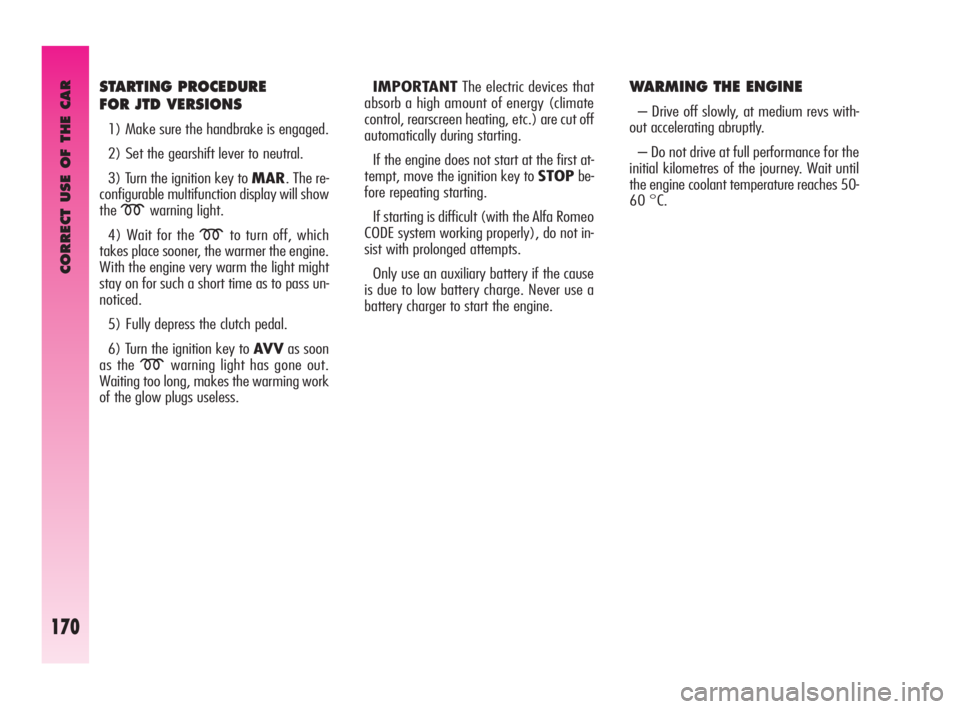
CORRECT USE OF THE CAR
170
STARTING PROCEDURE
FOR JTD VERSIONS
1) Make sure the handbrake is engaged.
2) Set the gearshift lever to neutral.
3) Turn the ignition key to MAR. The re-
configurable multifunction display will show
the
mwarning light.
4) Wait for the
mto turn off, which
takes place sooner, the warmer the engine.
With the engine very warm the light might
stay on for such a short time as to pass un-
noticed.
5) Fully depress the clutch pedal.
6) Turn the ignition key to AV Vas soon
as the
mwarning light has gone out.
Waiting too long, makes the warming work
of the glow plugs useless.IMPORTANTThe electric devices that
absorb a high amount of energy (climate
control, rearscreen heating, etc.) are cut off
automatically during starting.
If the engine does not start at the first at-
tempt, move the ignition key to STOPbe-
fore repeating starting.
If starting is difficult (with the Alfa Romeo
CODE system working properly), do not in-
sist with prolonged attempts.
Only use an auxiliary battery if the cause
is due to low battery charge. Never use a
battery charger to start the engine.
WARMING THE ENGINE
– Drive off slowly, at medium revs with-
out accelerating abruptly.
– Do not drive at full performance for the
initial kilometres of the journey. Wait until
the engine coolant temperature reaches 50-
60 °C.
Page 173 of 271
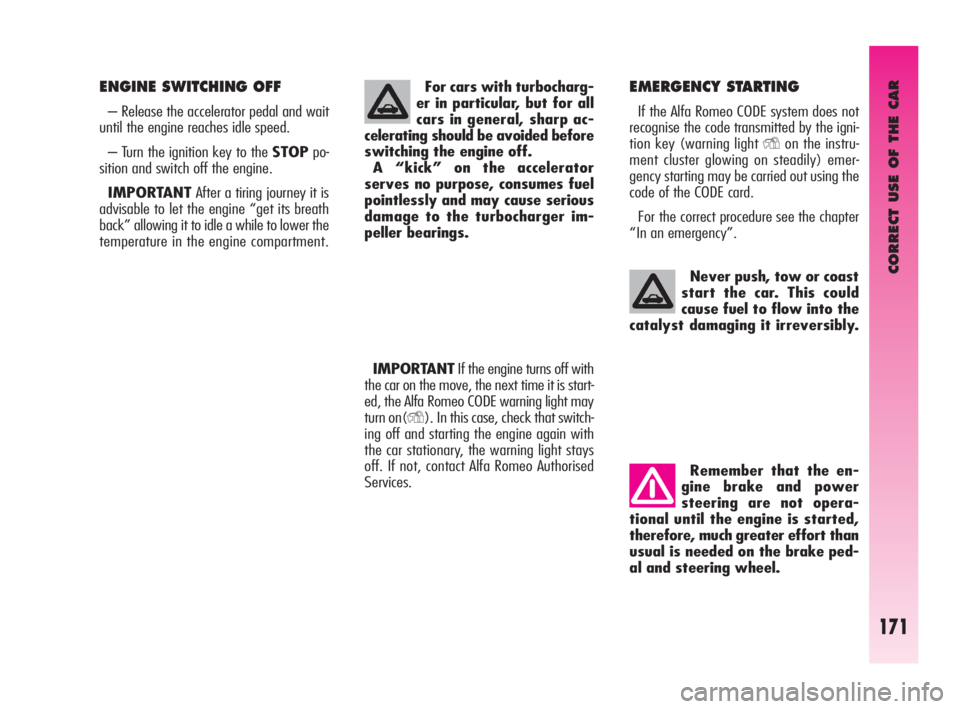
CORRECT USE OF THE CAR
171
Never push, tow or coast
start the car. This could
cause fuel to flow into the
catalyst damaging it irreversibly.
Remember that the en-
gine brake and power
steering are not opera-
tional until the engine is started,
therefore, much greater effort than
usual is needed on the brake ped-
al and steering wheel. For cars with turbocharg-
er in particular, but for all
cars in general, sharp ac-
celerating should be avoided before
switching the engine off.
A “kick” on the accelerator
serves no purpose, consumes fuel
pointlessly and may cause serious
damage to the turbocharger im-
peller bearings.
EMERGENCY STARTING
If the Alfa Romeo CODE system does not
recognise the code transmitted by the igni-
tion key (warning light
Yon the instru-
ment cluster glowing on steadily) emer-
gency starting may be carried out using the
code of the CODE card.
For the correct procedure see the chapter
“In an emergency”.
IMPORTANTIf the engine turns off with
the car on the move, the next time it is start-
ed, the Alfa Romeo CODE warning light may
turn on(
Y). In this case, check that switch-
ing off and starting the engine again with
the car stationary, the warning light stays
off. If not, contact Alfa Romeo Authorised
Services.
ENGINE SWITCHING OFF
– Release the accelerator pedal and wait
until the engine reaches idle speed.
– Turn the ignition key to the STOPpo-
sition and switch off the engine.
IMPORTANTAfter a tiring journey it is
advisable to let the engine “get its breath
back” allowing it to idle a while to lower the
temperature in the engine compartment.
Page 174 of 271
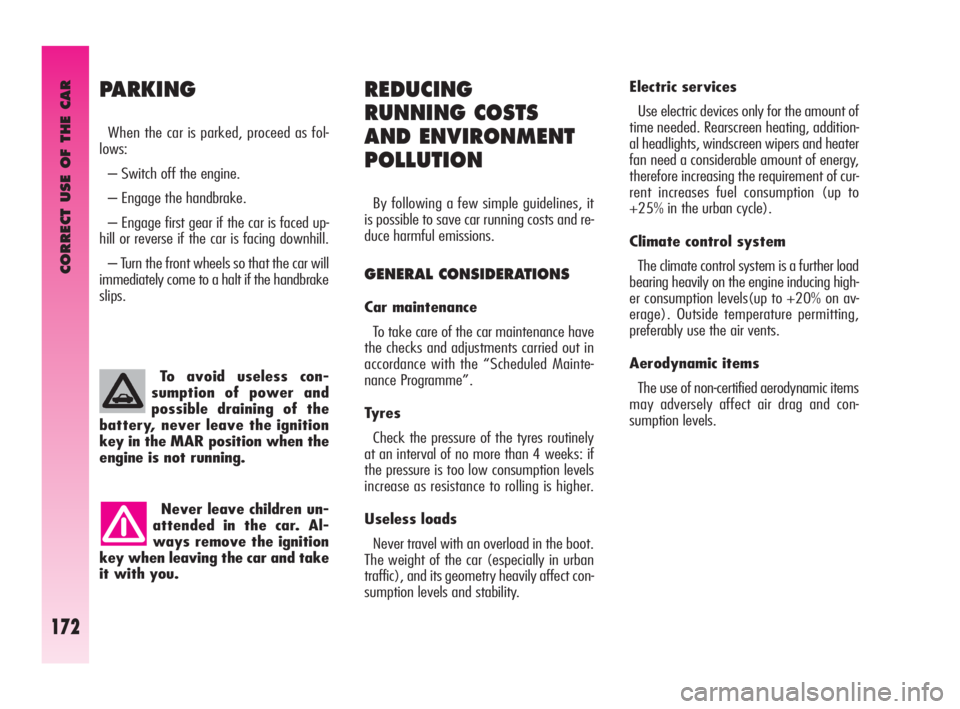
CORRECT USE OF THE CAR
172
Never leave children un-
attended in the car. Al-
ways remove the ignition
key when leaving the car and take
it with you.To avoid useless con-
sumption of power and
possible draining of the
battery, never leave the ignition
key in the MAR position when the
engine is not running.
PARKING
When the car is parked, proceed as fol-
lows:
– Switch off the engine.
– Engage the handbrake.
– Engage first gear if the car is faced up-
hill or reverse if the car is facing downhill.
– Turn the front wheels so that the car will
immediately come to a halt if the handbrake
slips.
REDUCING
RUNNING COSTS
AND ENVIRONMENT
POLLUTION
By following a few simple guidelines, it
is possible to save car running costs and re-
duce harmful emissions.
GENERAL CONSIDERATIONS
Car maintenance
To take care of the car maintenance have
the checks and adjustments carried out in
accordance with the “Scheduled Mainte-
nance Programme”.
Tyres
Check the pressure of the tyres routinely
at an interval of no more than 4 weeks: if
the pressure is too low consumption levels
increase as resistance to rolling is higher.
Useless loads
Never travel with an overload in the boot.
The weight of the car (especially in urban
traffic), and its geometry heavily affect con-
sumption levels and stability.Electric services
Use electric devices only for the amount of
time needed. Rearscreen heating, addition-
al headlights, windscreen wipers and heater
fan need a considerable amount of energy,
therefore increasing the requirement of cur-
rent increases fuel consumption (up to
+25% in the urban cycle).
Climate control system
The climate control system is a further load
bearing heavily on the engine inducing high-
er consumption levels(up to +20% on av-
erage). Outside temperature permitting,
preferably use the air vents.
Aerodynamic items
The use of non-certified aerodynamic items
may adversely affect air drag and con-
sumption levels.
Page 177 of 271

CORRECT USE OF THE CAR
175
For the electrical connection a 7 or 13 pole
12VDC connection must be used (CU-
NA/UNI and ISO/DIN standards) following
any reference instructions given by the car
Manufacturer and/or towing device Manu-
facturer.
Any electric brake should be supplied directly
by the battery through a cable with a cross-
section of no less than 2.5 mm
2. In addition
to the electrical branches, the car electric sys-
tem can only be connected to the supply ca-
ble for an electric brake and to the cable for
an internal light, though not above 15W.
INSTALLATION LAYOUT
(fig. 1)
The tow hook structure must be fas-
tened in the points shown by the sym-
bol
Øusing 4 M8 screws and 7 M10
screws.
The inner plate (2) should have a
minimum thickness of 6 mm.
The inner plate (3) should have a
minimum thickness of 4 mm.
The inner plate (4) should have a
minimum thickness of 5 mm.
The fastening points (1) should be fit-
ted with 25 mm x 6 mm spacers.After fitting, the fasten-
ing screw holes shall be
sealed to prevent exhaust
gas inlet.
IMPORTANTIt is compulsory to fasten
a label (plainly visible) of suitable size and
material with the following wording:
MAX LOAD ON BALL 60 kg.
Page 180 of 271
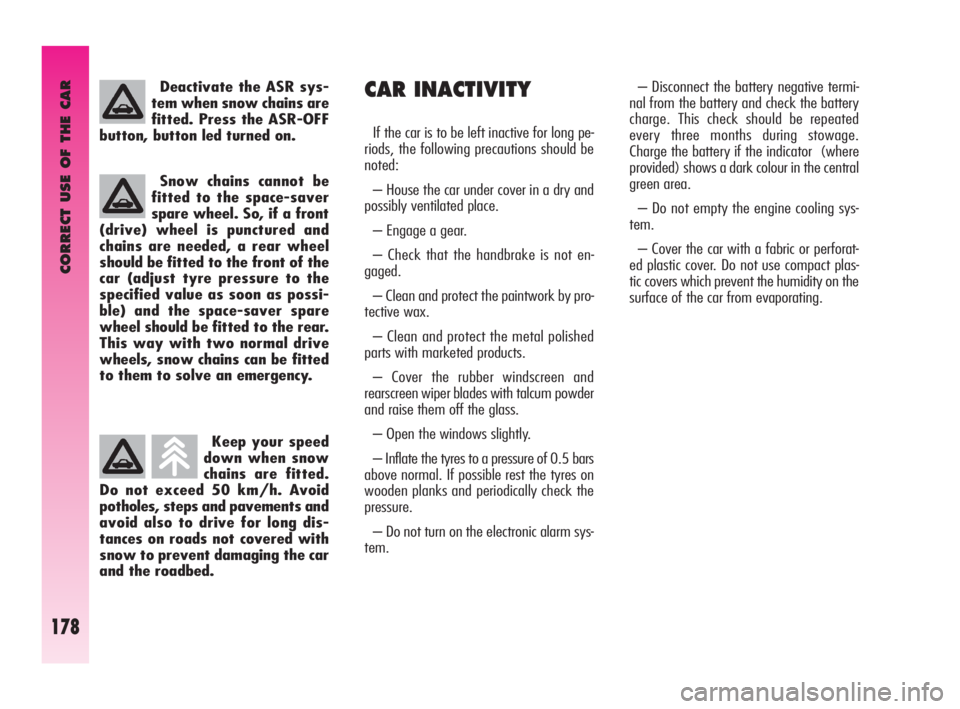
CORRECT USE OF THE CAR
178
Keep your speed
down when snow
chains are fitted.
Do not exceed 50 km/h. Avoid
potholes, steps and pavements and
avoid also to drive for long dis-
tances on roads not covered with
snow to prevent damaging the car
and the roadbed.
CAR INACTIVITY
If the car is to be left inactive for long pe-
riods, the following precautions should be
noted:
– House the car under cover in a dry and
possibly ventilated place.
– Engage a gear.
– Check that the handbrake is not en-
gaged.
– Clean and protect the paintwork by pro-
tective wax.
– Clean and protect the metal polished
parts with marketed products.
– Cover the rubber windscreen and
rearscreen wiper blades with talcum powder
and raise them off the glass.
– Open the windows slightly.
– Inflate the tyres to a pressure of 0.5 bars
above normal. If possible rest the tyres on
wooden planks and periodically check the
pressure.
– Do not turn on the electronic alarm sys-
tem.– Disconnect the battery negative termi-
nal from the battery and check the battery
charge. This check should be repeated
every three months during stowage.
Charge the battery if the indicator (where
provided) shows a dark colour in the central
green area.
– Do not empty the engine cooling sys-
tem.
– Cover the car with a fabric or perforat-
ed plastic cover. Do not use compact plas-
tic covers which prevent the humidity on the
surface of the car from evaporating. Snow chains cannot be
fitted to the space-saver
spare wheel. So, if a front
(drive) wheel is punctured and
chains are needed, a rear wheel
should be fitted to the front of the
car (adjust tyre pressure to the
specified value as soon as possi-
ble) and the space-saver spare
wheel should be fitted to the rear.
This way with two normal drive
wheels, snow chains can be fitted
to them to solve an emergency.
Deactivate the ASR sys-
tem when snow chains are
fitted. Press the ASR-OFF
button, button led turned on.
Page 183 of 271
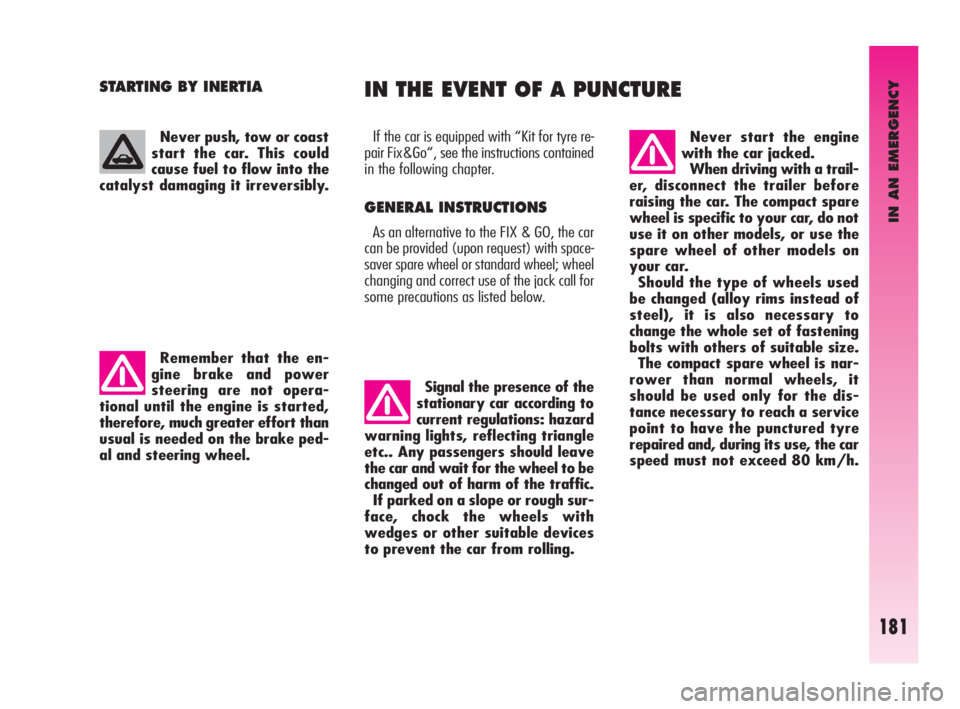
IN AN EMERGENCY
181
STARTING BY INERTIA
If the car is equipped with “Kit for tyre re-
pair Fix&Go“, see the instructions contained
in the following chapter.
GENERAL INSTRUCTIONS
As an alternative to the FIX & GO, the car
can be provided (upon request) with space-
saver spare wheel or standard wheel; wheel
changing and correct use of the jack call for
some precautions as listed below.
IN THE EVENT OF A PUNCTURE
Never push, tow or coast
start the car. This could
cause fuel to flow into the
catalyst damaging it irreversibly.
Remember that the en-
gine brake and power
steering are not opera-
tional until the engine is started,
therefore, much greater effort than
usual is needed on the brake ped-
al and steering wheel.
Signal the presence of the
stationary car according to
current regulations: hazard
warning lights, reflecting triangle
etc.. Any passengers should leave
the car and wait for the wheel to be
changed out of harm of the traffic.
If parked on a slope or rough sur-
face, chock the wheels with
wedges or other suitable devices
to prevent the car from rolling.
Never start the engine
with the car jacked.
When driving with a trail-
er, disconnect the trailer before
raising the car. The compact spare
wheel is specific to your car, do not
use it on other models, or use the
spare wheel of other models on
your car.
Should the type of wheels used
be changed (alloy rims instead of
steel), it is also necessary to
change the whole set of fastening
bolts with others of suitable size.
The compact spare wheel is nar-
rower than normal wheels, it
should be used only for the dis-
tance necessary to reach a service
point to have the punctured tyre
repaired and, during its use, the car
speed must not exceed 80 km/h.
Page 219 of 271

CAR MAINTENANCE
217
SCHEDULED MAINTENANCE PROGRAMME
20 40 60 80 100 120 140 160 180Thousands of km
Check tyre conditions/wear and adjust pressure if necessary
Check operation of lighting system (headlights, direction indicators,
hazard warning lights, boot, passenger compartment, glovebox lights, warning lights, etc..)
Check operation of windscreen washer system, adjust spray jets
Check position/wear of windscreen/rearscreen wiper blades
Check operation of front disk brake pad wear indicator
Check wear conditions of rear disk brake pads
Sight check the conditions of: body exterior, underbody protection, stiff pipes
and hoses (exhaust - fuel supply - brakes), rubber parts
(boots - sleeves - bushes etc..)
Check cleanness of locks, bonnet and boot and lever cleanness, and lubrication
Sight inspect accessory drive belt conditions
Check handbrake lever stroke adjustment
Change air cleaner cartridge (petrol versions)
Change air cleaner cartridge (JTD versions)
Top up fluid levels (engine coolant, brakes, windscreen washer, battery, etc..)
●●●●●●●●●
●●●●●●●●●
●●●●●●●●●
●●●●●●●●●
●●●●●●●●●
●●●●
●●●●●●●●●
●●●●●●●●●
●●
●●●●
●●●●
●●●●●●●●●
●●●●●●●●●
Page 220 of 271

●●●●●●●●●
●●
●●●●
●●●●
●●
●
●●●
●
●
●
●●●●●●●●●
●●●●●●●●●
●●●
●●●●●●●●●
●●●●●●●●●
CAR MAINTENANCE
218
20 40 60 80 100 120 140 160 180Thousands of km
Check and if necessary top up the Selespeed automatic transmission oil level
(2.0 JTS versions)
Sight check for conditions of timing gear drive toothed belt (3.2 V6 and JTD versions)
Check emissions/smoke at the exhaust (JTD versions)
Check operation of engine control system (through diagnosis socket)
Check mechanical transmission oil level
Change counter-rotating shaft drive belt
Change timing gear drive belt (1.8 T.SPARK and 2.0 JTS versions) (*)
Change timing gear drive belt (3.2 V6 and JTD versions) (*)
Change accessory poly-V drive belt
Change spark plugs (petrol versions)
Change engine oil and oil filter (petrol versions) (or every 24 months)
Change engine oil and oil filter (diesel with DPF versions)(**)
(or every 24 months)
Change engine oil and oil filter (diesel without DPF versions)(**)
(or every 24 months)
Change brake fluid (or every 24 months)
Change fuel filter (JTD versions)
Change pollen filter (or every year)
(*) Regardless of the km covered, the timing belt shall be replaced every 4 years for particularly demanding use (cold climates, driving in the city, idling for a long time) or in any case every 5 years.
(**) Engine oil and oil filter shall actually be changed according to the conditions of use of the car and it is indicated by the relevant warning light or message (where provided) on the instrument panel
(see “Warning lights and messages” paragraph).
If the car is used mainly on urban routes or if the yearly kilometres travelled are less than 10,000 km, the engine oil and filter must be changed every 12 months.